New products at Crocus
by Sarah - July 7th, 2010.Filed under: Crocus, New Products.
New products today at Crocus
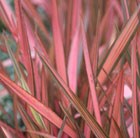
New Zealand flax (syn. Rainbow Sunrise) £14.99
Position: full sun/partial shadeSoil: fertile, well-drained soilRate of growth: averageFlowering period: July to AugustHardiness: frost hardy (may need winter protection)With their arching, strappy, sword-shaped leaves, Phormiums make a dramatic statement in the garden. Originating from New Zealand, where their fibre has traditionally been used in the same way as hemp or sisal, they are versatile evergreen plants that tolerate a range of conditions and look at home in a variety of different planting schemes. They have become increasingly popular in recent years, with more and more colourful varieties being introduced. As its name suggests, this one looks particularly exotic, with slender, apricot, gold, pink and bronze striped leaves. It is compact too, so try it as a specimen in a large container on the patio, or to provide structure among ornamental grasses. In hot summers, a spike of tubular, yellow-green flowers will shoot up from the centre, followed by sturdy seed-heads. Garden care: In late spring, remove any dead or damaged leaves and apply a mulch of well-rotted organic matter to stimulate vigorous, new growth.
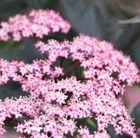
black elder (syn. Black Beauty) £9.99
Position: full sun or partial shadeSoil: moderately fertile, humus-rich, moist, well-drained soilRate of Growth: averageFlowering period: JuneFlowers: pale pinkOther features: purple black autumn fruits are attractive to birdsHardiness: fully hardyThis fantastic new variety of elder has intense, black burgundy foliage and sweet, lemon scented, pale pink flowers in early summer, opening from dark red buds. Darker than other varieties it makes an excellent ornamental plant for a site in sun or partial shade. As an added bonus the purple black autumn fruits are highly attractive to songbirds. Garden care: To achieve the best foliage effect cut back to ground level each year in early spring and apply a generous 5-7cm (2-3in) mulch of well-rotted garden compost or manure around the base of the plant.Goes well with: Salix alba var vitellina, Trollius europaeus, Primula florindae, Carex elata ‘Aurea’, Juncus effusus f. ‘Spiralis’, Hosta sieboldiana var. elegans.
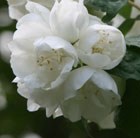
mock orange £9.99
Position: full sun or partial shadeSoil: fertile, well-drained soilRate of growth: fast-growing Flowering period: June and JulyHardiness: fully hardyIn June and July this lovely deciduous shrub is smothered with highly fragrant, double, pure white flowers among dark green leaves that turn yellow in autumn. This tall, vigorous variety of mock orange looks wonderful towards the back of a mixed or shrub border, where on warm summer evenings, the delicate, orange-blossom fragrance floats on the breeze. It is a magnet for bees and can also cope with urban pollution and salt-laden air. Garden care: Mulch around the roots in spring with a deep layer of well-rotted garden compost or manure. Prune in late summer, immediately after flowering, removing one in four of the older stems to ground level.
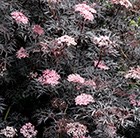
black elder (syn. Black Lace) £9.99
Position: full sun or partial shadeSoil: moderately fertile, humus-rich, moist, well-drained soilRate of Growth: averageFlowering period: JuneFlowers: pale pinkOther features: almost black, dissected leaves and blackish red berries in autumnHardiness: fully hardyThis recent introduction has almost black, dissected foliage and from May to June pale pink, musk-scented blooms emerge from beautiful creamy-pink buds. It makes an excellent shrub for all styles of gardens and has the added bonus of having blackish-red berries in autumn which are not attractive to birds, but when ripe it can be used to make a wonderful wine.Garden care: To achieve the best foliage effect cut back to ground level each year in early spring and apply a generous 5-7cm (2-3in) mulch of well-rotted garden compost or manure around the base of the plant.
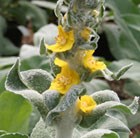
mullein £9.99
Position: full sunSoil: poor, well-drained, alkaline soilRate of growth: average Flowering period: July to August Flower colour: butter yellowHardiness: fully hardyAn attractive rosette-forming biennial that is covered in silky silver hairs. In summer tall spikes of saucer-shaped, butter yellow flowers appear above white-woolly basal leaves. A stunning plant for the back of a sunny border or planted in dramatic swathes in an island bed.Garden care: Mullein moth caterpillars can be a problem, so look out for them in early June and pick them off as soon as they appear. Remove faded flower-spikes. Apply a thick 5-7cm (2-3in) mulch around the base of the plant in early spring.It is worth keeping in mind that these plants are mainly biennial, so although they usually self-seed freely, the plant will only live for two years
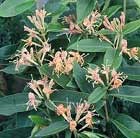
honeysuckle £8.99
Position: full sun or partial shadeSoil: fertile, humus-rich, moist, well-drained soilRate of growth: average to fast-growingFlowering period: June to JulyHardiness: fully hardy (borderline)Purplish-red, tubular flowers with yellow-throats, smother this honeysuckle in June and July and are often followed by small, shiny, black fruits. The handsome, tapered, glossy, dark green leaves are retained all year, so this vigorous variety is ideal for covering a pergola, arch or boundary wall. It is happy in partial shade.Garden care: Cut back established plants after flowering, removing a third of the flowering shoots. Apply a generous 5-7cm (2-3in) mulch of well-rotted compost or manure around the base of the plant in early spring.
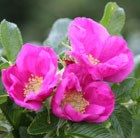
rose (shrub) £8.99
Position: full sunSoil: fertile, humus-rich, moist, well-drained soilRate of growth: fast-growingFlowering period: July to SeptemberFlower colour: purplish-redOther features: excellent cut-flowersHardiness: fully hardyMasses of fragrant, single, yellow-centred, purplish-red flowers from July to September, followed by attractive, tomato-shaped, red or orange-red rose-hips. This vigorous, repeat-flowering species rose is ideal for wilder areas of the garden. An excellent, informal, flowering hedge for an open, sunny site, the leathery, dark-green leaves turn butter-gold in autumn.To find out more about how to plant a hedge, click hereGarden care: Before planting shorten thick roots to 25cm (10in) and reduce top-growth to an outward-facing bud 8-15cm (3-6in) above ground-level. Plant during a frost-free spell, incorporating well-rotted organic matter and a balanced fertiliser into the planting hole. Ensure that the ‘bud union’ (the bulge at the base of the shoots) is 2.5cm (1in) below the soil.All our roses are field grown. In October/November they are dug up and potted. However, they will not produce any new roots until spring, so don’t be surprised if the compost falls away from the roots when winter planting. Some suppliers send out ‘bare root’ plants unpotted, but we don’t as it is easier to manage them on the nursery in pots.

lesser periwinkle £7.99
Position: full sun or partial shadeSoil: any but very dry soilRate of growth: average to fast-growing Flowering period: April to September Flower colour: lavender-blueHardiness: fully hardyPretty, pale blue or blue-violet flowers from April to September and lance-shaped, dark green leaves. This pretty, prostrate, evergreen shrub is excellent groundcover for the smaller garden. One of our recommended plants, it’s less invasive than Vinca major and grows in any well-drained soil in sun or partial shade.Garden care: To prevent the plant from becoming invasive cut back any unwanted shoots in spring.

shrubby veronica £7.99
Position:full sun or partial shadeSoil:poor or moderately fertile, moist, well-drained neutral to slightly alkaline soilRate of growth: averageFlowering period: May and JuneHardiness: fully hardyMasses of pure-white flowers on purple stems in late spring and early summer and fleshy, blue-green leaves. This neat, semi-prostrate evergreen shrub is an attractive groundcover plant for the front of a border in sun or part-shade and also looks good among silver-leaved plants. It is salt and pollution tolerant and therefore suitable for city or coastal gardens. Garden care:Needs minimal pruning. Remove misplaced or frost damaged branches in late spring.
veronica £7.99
shrubby veronica £7.99
bistorta £6.99
bergamot £6.99
rock cranesbill £6.99
Corsican hellebore £6.99
lupin £6.99
rosemary £6.99
culver’s root £6.99






